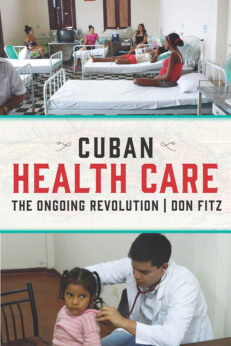
If they are paying attention, progressives worldwide know that Cuba provides health care that saves lives and prevents disease more effectively than does the United States, its major capitalist enemy. They know that Cuban health workers have been caring for people throughout the global South and, during the COVID-19 pandemic, in Europe, too. And the word is out that Cuba educates vast numbers of physicians for service in much of the world.
Many U.S. fans of Cuba’s Revolution know that, early on, care was extended to desperate rural areas of the island, that a large number of new health workers were trained, that disease prevention was prioritized. They may know that health care planners pioneered in devising an exemplary primary medical care system. They had tried and abandoned versions of the so-called polyclinics, then arrived at the pathbreaking family doctor-nurse program.
The polyclinics featured general practitioners, pediatricians, gynecologists, dentists, pediatricians, and sometimes psychologists working in one setting. Once the family doctor-nurse teams took responsibility for primary care, in 1984, the polyclinics were assigned consulting and teaching duties. Essential to the family doctor-nurse program was the creation of a new medical discipline, comprehensive general medicine, for which a new post-graduate, multi-year training program was created.
Cuban Health Care, written by Don Fitz and recently published by Monthly Review Press, explores these developments and more. Fitz explains how health care was integrated into the community and how the notion of health itself came to include social, psychological, economic, and nutritional wellbeing. His book surveys Cuba’s highly successful management of the HIV/AIDS epidemic; the role of Cuban doctors—and anti-apartheid soldiers—in Southern Africa; disaster relief and general health care provided in countries throughout the world; and medical training for tens of thousands of young people from Latin America, Africa, and even Asia and the United States. Fitz explores the origins and mission of Cuba’s Latin American School of Medicine (ELAM) that between 2006 and 2019 provided training at no personal cost for 29,749 students from 115 nations.
Readers of this valuable book learn about difficulties confronted by Cuban leaders as they developed a new kind of health system. These included shortages of medical practitioners and teachers due to emigration in the early 1960s, competing revolutionary goals, frictions with Cuba’s Soviet ally, fallout from the collapse of the Soviet Bloc, harmful effects of the U.S. economic blockade, and false accusations of homophobia directed at those responsible for Cuba’s HIV/AIDS treatment program.
The author points out that Cubans were able to change their health care system only because of revolutionary change in the larger society. He praises Cuban health care as emblematic for what a revolution can achieve. His insertion of a chapter on the failings of U.S. healthcare—and a very coherent account it is—conveys the suggestion that the Cuban model may be of use to health care reformers in the United States.
No specifics are offered—and certainly no call for political revolution in the United States. Fitz critiques U. S. health care in terms like “profit-based health care,” or the “sickness industry,” but with little explicit reference to capitalism. He finds solutions in a “post-capitalist society” or through “the emergence and consolidation of a new consciousness,” not with socialist change per se in the United States.
Cuban Health Care benefits from the author’s first-hand observations and from his interviews with providers, officials, and students—particularly students at ELAM—and interviews conducted by others that he cites. Many of the personal experiences and opinions expressed in the interviews convey revolutionary purpose, enthusiasm for change, and hope for a better world. Several former Cuban soldiers deployed in Southern Africa to fight apartheid offer reflections that, intentionally or not on the author’s part, lay out the horrors of war.
 Don Fitz’s book brings together information on Cuba’s Revolution and Cuba’s brand of health care; it communicates a vision of progressive social change. Clearly written and easily read, it deserves a wide audience.
Don Fitz’s book brings together information on Cuba’s Revolution and Cuba’s brand of health care; it communicates a vision of progressive social change. Clearly written and easily read, it deserves a wide audience.
It must be noted that information, opinion, and data appearing in some chapters had already been communicated in earlier chapters. Articles the author had earlier written for periodicals found new life as chapters in his book, and those articles may have harbored the repetitions. Plus, some data in the book are not current, due perhaps to failure to update data taken from the older articles included.
This is a wide-ranging book, but significant aspects of Cuban health care escaped mention. For example, Cuban health care planners are pragmatic. Ready to abandon tradition or an initiative if it doesn’t work, they experiment—as illustrated by their course moving from one kind of polyclinic to another, and ultimately to the family doctor-nurse program. And, as reported by Fitz, the prevailing mode of scientific medicine co-exists with community-based healing practices.
Secondly, health care renovation in Cuba made ample provision for complicated and/or unusual illnesses, to be expected of any health system, revolutionary or not, aiming at comprehensive care. Cuba has maintained an expanded corps of clinical specialists and scientists and supported a variety of specialized care institutions.
The New England Journal of Medicine reported (Dec. 8, 1983) that “Cuba has engineered a national medical apparatus that is the envy of many developing nations. For some of these nations, it is not Boston, Massachusetts, but Havana, Cuba, that is the center of the medical world.” The report describes “National medical institutes [that] carry out highly specialized procedures, such as kidney transplantations and some heart operations…. Children are sent to separate pediatric facilities, and almost all newborns (98.9 percent) are delivered in maternity hospitals. Cuba has a wide range of hospitals offering kinds of specialized care. [And] most of the drugs (83 percent) used in Cuba are manufactured by its own pharmaceutical industry.”
For a blockaded, impoverished, and tiny nation over the course of a few years to have prepared and mobilized skilled personnel and to have arranged for supplies, equipment, and appropriate physical structures was an extraordinary achievement.
Third, Cuban revolutionaries in power embarked upon a many-faceted bio-medical-pharmacological venture with research and production capabilities. Cuban-produced vaccines, drugs, and other therapeutic and testing products have benefited Cubans themselves and peoples throughout the world. Export sales of these products have provided much-needed foreign currency.
In a recent report, analyst Charles McKelvey states that “In the period 1962 to 1973, fifty-three ‘units of science and technology’ were created, including research institutions in the natural sciences, medicine, technology, agricultural sciences, and social sciences. … On October 17, 1962, the ‘Victoria de Girón’ Institute of Preclinical and Basic Sciences was inaugurated. Formed by a group of fifteen university professors of medicine and other teaching and laboratory personnel, its mission was to strengthen education in the medical sciences. However, it soon became evident that it was necessary to considerably expand the facilities for biomedical research.”
Fourth, a defining characteristic of Cuban-style health care is competence. Measuring competence in such an arena verges on the impossible, but there are indications. In her 1991 report on “the Road to a Family Medicine Nation” in 1991, Margaret Gilpin describes an elaborate process toward that end. Advice was sought from other countries and from international agencies. Multiple planning commissions were involved. The introductory phase was closely watched. Little was left to chance.
It must be noted, lastly, that the book devotes little attention to the struggle between social classes as contributing to a progressive mode of healthcare. The author emphasizes instead the creativity and initiative of individuals, as with his final chapter entitled, “How Che Guevara Taught Cuba to Confront COVID-19.” Our idea is that Cuba’s brand of health care grew out of social stresses, and out of ideological ferment. The socialist roots of Cuban healthcare are not explored.
The book sporadically mentions the adverse effects of the U.S. economic blockade against Cuba, which indeed is a manifestation of class conflict in the international sphere. The author missed the opportunity in his hands of systematically condemning the U.S. blockade as he was praising health care in Cuba.
Cuban Health Care: The Ongoing Revolution
by Don Fitz
New York: Monthly Review Press, 2020
303 pp., $26.
ISBN paper: 978-1-58367-860-2
monthlyreview.org










